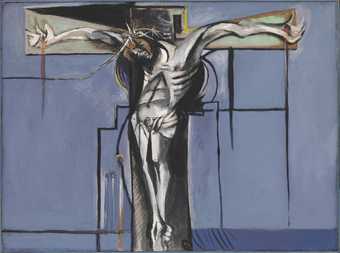
Graham Sutherland OM
Crucifixion (1946)
Tate
It was in this country that I began to learn painting. It seemed impossible, here, for me to sit down and make finished paintings ‘from life’. Indeed, there were no ‘ready made’ subjects to paint. The spaces and concentrations of this clearly constructed land were material for storing in the mind. Their essence was intellectual and emotional, I found that I could express what I felt only by paraphrasing what I saw. I felt just as much part of the earth as my features were part of me. I did not feel that my imagination was in conflict with the real, but that reality was a dispersed and disintegrated form of imagination.
If at first I attempted to make pictures here on the spot, I soon gave this up. It became my habit to walk through and soak myself in the country. I never forced myself here, or consciously looked for subjects. Sometimes, lying through sheer laziness on the warm shore, my eye became riveted to what it would – some sea-eroded rocks, for instance, which I would notice were reproducing, precisely in miniature, the forms of the inland hills.
These and other things delighted me, the twisted gorse on the cliff edge (such as suggested the picture Gorse on Sea Wall), twigs, like snakes, lying on the path, the bare rock, worn and showing though the path, heath hits, gorse burnt and blackened, the high overhanging hedges by the steep rods, which pinch the setting sun, mantling clouds, and the thunder, the deep green valleys and the rounded hills – and the whole structure simple and complex.
I learnt that landscape was not necessarily scenic, and found that its parts have an individual figurative detachment.
When one goes for a walk there is everything around one; but one reacts to certain things only, as in response to some personal need of the nerves. The reaction varies; I may have noticed a certain juxtaposition of forms at the side of a road, but on passing the same place next time, I might look for them in vain. It was only at the original moment of seeing that they had significance for me.
If, sometimes, I make notes, it is in order that I might take the intricacy of my subject home with me, as it were. In the studio I react afresh. The images dissolve, objects lose their normal environment and relationship. Then things seem to be drawn together and redefined in the mind’s eye.
One must avoid the danger of rationalising the workings of the mind, which are often irrational and certainly mysterious.
About my thorn pictures: I had been thinking of the Crucifixion (I was about to attempt this subject), and my mind was preoccupied by the idea of thorns, and wounds made by thorns. In the country I began to notice thorn bushes and the structure of thorns, which pierced the air in all directions, their points establishing limits of aerial space. I made some drawings and in doing so a strange change took place. While preserving their normal life in space, the thorns rearranged themselves and became something else – a sort of paraphrase of the Crucifixion and the Crucified Head – the cruelty.
For myself I believe that a new vision must be grafted on reality, that the mysteriously intangible must be made immediate and tangible, and vice versa. My forms are based on the principles of organic growth (with which I have always been preoccupied). My Standing Forms, to me, are monuments and presences. But why use these forms instead of human figures? Because, at the moment, I find it necessary to catch the taste, the quality, the essence of the presence of the human figure (the mysterious immediacy of a figure standing in a room or against a hedge in its shadow, its awareness, its regard, as if one had never seen it before) by a substitution. Again, at the moment, I find that I can make these qualities more real to myself in this way. I find these organic forms best for my purpose. They themselves are emotionally modified from the natural prototype. They give me a sense of the shock of surprise which direct evocation could not do. I am trying to return these forms, after drastic rearrangement and formal modification, to a field of greater visual response, to throw them back, as it were, into the original cradle of impact.
It has been said that my most typical images express a point of view dark and pessimistic. That is foreign to my mind. The precarious tension of opposites (happiness and unhappiness, beauty and ugliness) so near the point of equilibrium, can be interpreted, perhaps, according to the predilections and needs of the spectator with delight or horror, as with the taste of bitter-sweet fruit. The painter is a kind of blotting paper; he soaks up impressions; he is very much part of the world. He cannot therefore avoid soaking up the implications of the apparent tragedy of twentieth-century civilisation. Subconsciously tragic pictures may be painted and without, necessarily, having a tragic subject.
It is necessary to work parallel with nature, according to one’s personal temperaments and needs. We are deceived if we work contrary to our inclinations or to nature.
Notes by the Artist.
